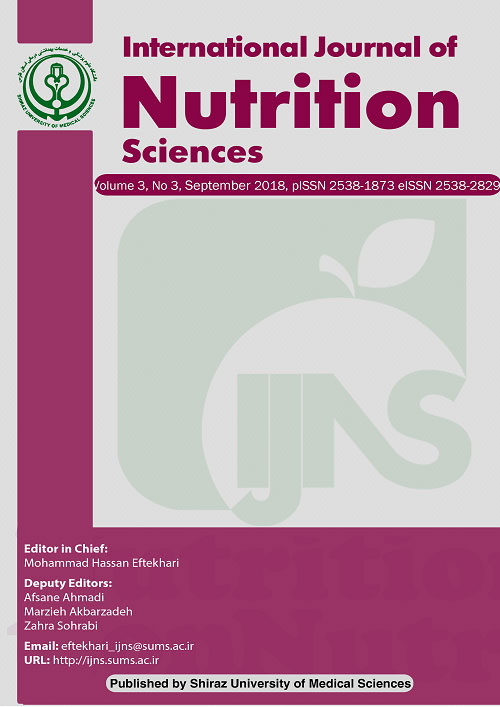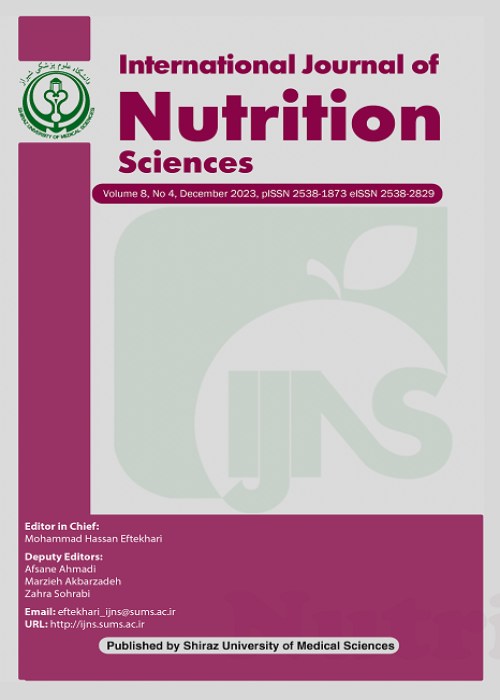فهرست مطالب

International Journal of Nutrition Sciences
Volume:5 Issue: 2, Jun 2020
- تاریخ انتشار: 1399/03/12
- تعداد عناوین: 8
-
-
Pages 49-53
Stevia is a sweet calorie-free plant used in food industry as a sweetener in beverages and foods. Lots of studies have been done on its efficacy, including its effects on weight, blood glucose, lipid profile, inflammation, etc. Recently, this plant has attracted diabetics, due to its low calorie sweetness. Diabetes is a chronic metabolic disease with an increasing prevalence, that the government and patients spend a great deal of money on treatment each year. Therefore, in this study, we aimed to investigate the effects of stevia supplementation in diabetic patients. Studies have shown that only a few studies have been conducted on diabetic patients, while many animal studies are available. Our review of these studies showed that stevia is a safe herb for diabetics and may have therapeutic effects, if used at a pharmacological dose, although more detailed studies are needed.
Keywords: Stevia, diabetes mellitus, Fasting blood glucose, HbA1C, Weight -
Pages 54-60
Vitamin D plays an important role in the body. Beyond its role in bone metabolism, this vitamin is involved in regulating immune and hormonal responses, antioxidant activity, cell proliferation and differentiation, and the prevention of various diseases. Vitamin D deficiency was shown to decrease the risk of inflammatory diseases including multiple sclerosis (MS) and inflammatory bowel disease (IBD). Vitamin D can affect the diversity and composition of the gut microbiota, which can be associated to a wide range of physiological processes, and disruption of gut microbiota was shown to be related to inflammation, metabolic disorders, excessive fat accumulation, and loss of insulin sensitivity. Some of theanti-inflammatory effects of vitamin D may be related to the changes in the composition of the intestinal microbiota. This study aimed to review the relationship between vitamin D and gut microbiota.
Keywords: Gut microbiota, Vitamin D, Inflammatory diseases -
Pages 61-68BackgroundType 2 diabetes is a progressive disease. This study Compared effects of combination of turmeric, ginger and cinnamon hydroalcoholic extracts with metformin on body weight, glycemic control, inflammation, oxidative stress and pancreatic histopatalogical changes in diabetic rat.MethodsRats were randomly assigned to four groups of 13 animals. Diabetes was induced by a single injection of streptozotocin (STZ, 65 mg/kg) and nicotinamide (110 mg/kg, 15 min before STZ injection). Normal control (NC) and diabetic control (DC) rats received 1 mL of distilled water and two other diabetic groups received either 300 mg/kg (HETGCC) or 100 mg/kg metformin for 6 weeks.ResultsHETGCC and metformin significantly decreased serum glucose, glycated hemoglobin (HbA1c), Homeostatic Model Assessment for Insulin Resistance (HOMA index), total cholesterol (TC), low-density lipoprotein cholesterol (LDL-C), and malondialdehyde (MDA) levels and significantly increased high-density lipoprotein cholesterol (HDL-C) concentrations compared to DC group. A significant increase in the number and diameter of the islets of Langerhans (IL) and body weight was seen in HETGCC group compared to DC rats and a significant increase in quantitative insulin sensitivity check index (QUICKI) was observed in metformin treated group. HETGCC and metformin did not have significant effects on hsCRP, insulin and triglyceride (TG) concentrations in diabetic rats.ConclusionHETGCC was shown to reduce the risk of diabetes and improve complications associated with diabetes such as hyperglycemia,dyslipidemia, oxidative stress, inflammation, histopathological statue of islets of Langerhans and weight loss in T2D patients.Keywords: Turmeric, Ginger, Cinnamon Metformin, diabetes mellitus
-
Pages 69-75BackgroundOkra (Abelmoschus esculentus) is a vegetable with fiber, vitamin C and flavonoids that can delay emptying of the stomach and cause longer satiety based on the fiber contents so that calorie intake is reduced. The presence of vitamin C and flavonoids in okra acts as an antioxidant that can fight free radicals and detain oxidative stress caused by hyperglycemia. This study aimed to compare the effect of steamed and boiled okra on fasting blood glucose levels in patients of type 2 diabetes mellitus with hypercholesterolemia.MethodsThe independent variables consisted of steamed and boiled okra and the dependent variable was fasting blood glucose level. Forty patients who suffered from type 2 diabetes mellitus and with hypercholesterolemia were enrolled and divided into three groups including the control group (G1), treatment group of G2 (boiled okra intervention as much as 40 g for 14 days) and G3 (steamed okra intervention as much as 40 g for 14 days).ResultsA greater decrease in fasting blood glucose level was noted for boiled okra group when compared with steamed okra group among patients suffering from type 2 diabetes mellitus and with hypercholesterolemia.ConclusionAdministration of boiled and steamed okra as much as 40 g for 14 days was shown to reduce fasting blood glucose level among patients suffering from type 2 diabetes mellitus and with hypercholesterolemia.Keywords: Okra_Abelmoschus esculentus_Fasting blood glucose_Type 2 diabetes mellitus_Hypercholesterolemia
-
Pages 76-82BackgroundPolycystic ovary syndrome (PCOS) is the cause of infertility among 75% of women. This study aimed to assess dietary intake, eating behaviors and body image among women with and without PCOS.MethodsTotally, 116 patients with PCOS and 116 subjects without PCOS who referred to Hazrat Zeinab Hospital affiliated to Shiraz University of Medical Sciences, Shiraz, Iran were enrolled. In this cross-sectional, descriptive analytical study, the demographic and 24-hour diet recall, emotional eating (EEQ), and multidimensional bodyself relationship (MBSRQ) questionnaires and physical activity were recorded for all participants.ResultsThe percentage of dietary protein (P=0.005) and eicosapentaenoic acid intake (P=0.024) in non-PCOS group was significantly higher than PCOS patients. There was a difference between the two groups regarding mean body mass index (BMI) (P=0.001), physical activity (P=0.327), EEQ (P=0.153) and the individual’s attitude toward the mental image of their body by MBSRQ (P=0.377). No significant difference was noted among PCOS patients regarding carbohydrate, fiber, and saturated fatty acid intake, when compared with non-PCOS group.ConclusionMBSRQ and EEQ scores were lower among PCOS patients, denoting to the need for investigation on a larger sample size.Keywords: Polycystic ovary syndrome, Dietary intake, Eating behavior, Body image, Woman
-
Pages 83-87BackgroundObesity and overweight are the main risk factors for several chronic diseases with a rising trend in recent years. Obesity is multifactorial and is related to nutritional status of people and is correlated with the dietary diversity. This study investigated the relationship between dietary diversity score (DDS) and abdominal obesity among female students.MethodsIn this cross-sectional study, 120 female students of Shiraz University of Medical Sciences, Shiraz, Iran were enrolled. Weight, height, waist circumference (WC) were measured according to standard procedures, and body mass index (BMI) was calculated. Also, their dietary intake was recorded using a 24-hour diet recall questionnaires. DDS was calculated using food grouping based on the food pyramid guide. The relationship between DDS and anthropometric indicators was statistically assessed.ResultsBMI was shown to be 21.94±4.66 kg/m2 and the WC was 79±11 cm. The DDS ranged from 1.7 to 9.4. BMI and waist circumference were significantly different between DDS quartiles; compared to the highest DDS quartile, subjects with the lowest DDS quartile had higher BMI and WC. The prevalence of obesity and overweight was less among participants with higher DDS.ConclusionOverweight, obesity as well as abdominal obesity were demonstrated to be inversely correlated to DDS, so that with an increase in DDS, overweight, and obesity as well as abdominal obesity decreased.Keywords: Dietary diversity score, Obesity, Body mass index, Waist circumference
-
Pages 88-93BackgroundAdolescents would like to search for information about various foods before consumption via social media such as Facebook and Instagram too. This study was undertaken to determine the effect of nutritional booklets on knowledge and consumption of fattening foods among adolescents of Surakarta, Indonesia.MethodsThis study analyzed the effect of nutritional booklets and social media on knowledge and consumption of fattening-foods among adolescents. In a quasi experiment using nonequivalent control group during a period of 30 days, three high schools of 1st, 3rd, and 5th grade in Surakarta, indonesia were enrolled including 34, 33 and 29 students,respectively based on a probability proportional sampling method. Nutritional education was carried out via nutritional booklets and social media during two weeks.ResultsNutritional education using nutritional booklets was significantly more effective on knowledge and consumption of fattening foods.ConclusionOur findings showed that nutritional booklets and social media could ignificantly influence the knowledge and consumption of fattening foods among adolescents. Even the effect of nutritional booklets was more prominent.Keywords: Booklet, Media, Fattening foods, Adolescent, Indonesia
-
Pages 94-101BackgroundScientific investigations revealed that dietary habits of students attending higher education are still inadequate and below the recommended consumption of fruits and vegetables with higher consumption of foods rich in fats, salt and sugar. This study aimed to evaluate the knowledge, attitude and practice on healthy diet among Portuguese university students.MethodsA cross-sectional study was conducted among 840 university students, using a self-reported questionnaire, previously validated. The questionnaire, in addition to the sociodemographic questions, included a scale of healthy dietary knowledge, attitude and behavior.ResultsThe university students were shown to have low healthy dietaryknowledge, moderate healthy dietary attitude and unhealthy dietary habits during the last 7 days. Regarding healthy dietary knowledge, the female students and respondents of natural sciences had the highest score. Considering healthy dietary practice, the older students and the students who changed residence at the time of entrance to higher education had the lowest score. There was a statistically significant and positive correlation between knowledge and practice, knowledge and attitude and finally between attitude and practice.ConclusionThese findings might help health educators and policy makers to promote and to develop healthy dietary attitudes and practices. Interventions targeting university students seem to be necessary to increase the knowledge on healthy dietary behaviours regarding three main topics of planning and preparing healthy meals, nutritional recommendations and food labels.Keywords: Diet, Knowledge, Attitude, Practice, Portugal


